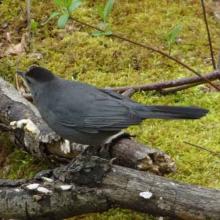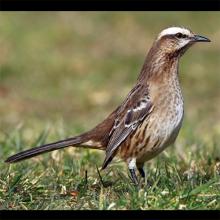Dumetella carolinensis
Common name:
Gray catbird
Genus:
Dumetella
Family:
Mimidae
Suborder:
-n/a-
Mimus thenca
Common name:
Chilean mockingbird
Genus:
Mimus
Family:
Mimidae
Suborder:
-n/a-
Dumetella carolinensis
Common name:
Gray catbird
Genus:
Dumetella
Family:
Mimidae
Suborder:
-n/a-
Mimus thenca
Common name:
Chilean mockingbird
Genus:
Mimus
Family:
Mimidae
Suborder:
-n/a-
Dumetella carolinensis
Common name:
Gray catbird
Genus:
Dumetella
Family:
Mimidae
Suborder:
-n/a-
Mimus thenca
Common name:
Chilean mockingbird
Genus:
Mimus
Family:
Mimidae
Suborder:
-n/a-
Family (Animalia): Mimidae
The mimids are the New World family of passerine birds, Mimidae, that includes thrashers, mockingbirds, tremblers, and the New World catbirds. As their name (Latin for "mimic") suggests, these birds are notable for their vocalization, especially some species' remarkable ability to mimic a wide variety of birds and other sounds heard outdoors.
Description
There are over 30 species of mimids in two larger and some 10 small or monotypic genera. They tend towards dull grays and browns in their appearance, though a few are black or blue-gray, and many have red, yellow, or white irises. They range from 20 to 33 centimeters in length, and 36 to 56 grams in weight. Many mimids have a rather thrush-like pattern: brown above, pale with dark streaks or spots below. They tend to have longer tails than thrushes (or the bigger wrens, which they also resemble) and longer bills that in many species curve downward.
They have long, strong legs (for passerines) with which many species hop through undergrowth searching for arthropods and fruits to eat. Their habitat varies from forest undergrowth to scrub, high-altitude grasslands, and deserts. The two tremblers live in the atypical habitat of rain forests in the Lesser Antilles, and the brown trembler has the particularly atypical behavior of foraging while clinging to tree trunks.
All known species build somewhat messy, bulky twig nests in dense growth, in most species on the ground or no more than 2 meters up. They usually lay 2 to 5 eggs that hatch in 12 or 13 days, which is also the length of time the chicks stay in the nest. Breeding usually starts in the spring or early in the rainy season, and many species can have two or even three broods per year. Most failures to fledge young are due to predation. Pairs often stay together for more than one breeding season.
Reference: Wikipedia


